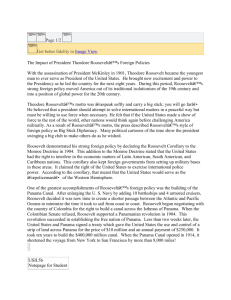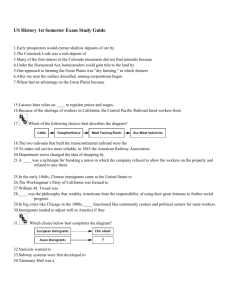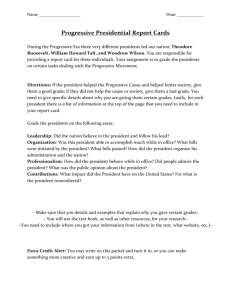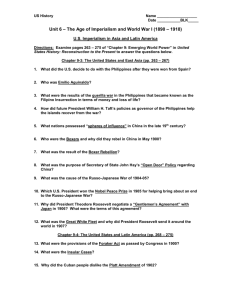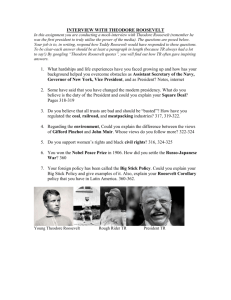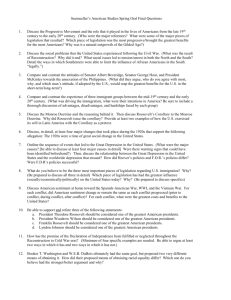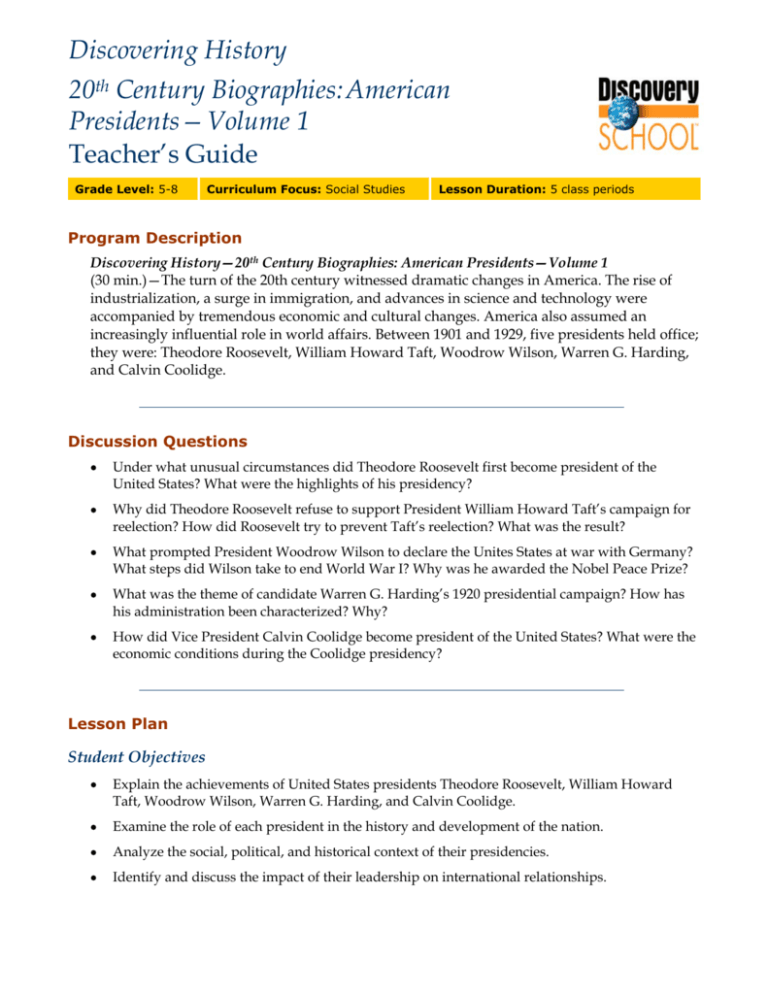
Discovering History
20th Century Biographies: American
Presidents—Volume 1
Teacher’s Guide
Grade Level: 5-8
Curriculum Focus: Social Studies
Lesson Duration: 5 class periods
Program Description
Discovering History—20th Century Biographies: American Presidents—Volume 1
(30 min.)—The turn of the 20th century witnessed dramatic changes in America. The rise of
industrialization, a surge in immigration, and advances in science and technology were
accompanied by tremendous economic and cultural changes. America also assumed an
increasingly influential role in world affairs. Between 1901 and 1929, five presidents held office;
they were: Theodore Roosevelt, William Howard Taft, Woodrow Wilson, Warren G. Harding,
and Calvin Coolidge.
Discussion Questions
•
Under what unusual circumstances did Theodore Roosevelt first become president of the
United States? What were the highlights of his presidency?
•
Why did Theodore Roosevelt refuse to support President William Howard Taft’s campaign for
reelection? How did Roosevelt try to prevent Taft’s reelection? What was the result?
•
What prompted President Woodrow Wilson to declare the Unites States at war with Germany?
What steps did Wilson take to end World War I? Why was he awarded the Nobel Peace Prize?
•
What was the theme of candidate Warren G. Harding’s 1920 presidential campaign? How has
his administration been characterized? Why?
•
How did Vice President Calvin Coolidge become president of the United States? What were the
economic conditions during the Coolidge presidency?
Lesson Plan
Student Objectives
•
Explain the achievements of United States presidents Theodore Roosevelt, William Howard
Taft, Woodrow Wilson, Warren G. Harding, and Calvin Coolidge.
•
Examine the role of each president in the history and development of the nation.
•
Analyze the social, political, and historical context of their presidencies.
•
Identify and discuss the impact of their leadership on international relationships.
Discovering History
20th Century Biographies: American Presidents—Volume 1
Teacher’s Guide
•
Analyze the changing role of the United States in world affairs.
•
Create a timeline of significant events during the presidencies of Roosevelt, Taft, Wilson,
Harding, and Coolidge.
•
Research and debate the topic of isolationism vs. America’s involvement in WWI.
•
Research and write a report on the life and legacy of one of the five presidents.
2
Materials
•
Discovering History—20th Century Biographies: American Presidents—Volume 1 video
•
Computer with Internet access
•
Print resources about United States presidents Theodore Roosevelt, William Howard Taft,
Woodrow Wilson, Warren G. Harding, and Calvin Coolidge
•
Print resources on the following topics: the Panama Canal, the Russo-Japanese War, the Rough
Riders, Spanish-American War, robber barons, League of Nations, women’s suffrage, Teapot
Dome Scandal, and Kellogg-Briand Peace Pact
•
Art materials for making posters (Procedure #9)
Procedures
1. Prior to viewing the program, ask students to share what they know about people or events in
American history during the period 1900 to 1929. You may wish to refer to the vocabulary
section of this guide and discuss terms unfamiliar to students. On the board, print the names of
the presidents presented in the program: Theodore Roosevelt, William Howard Taft, Woodrow
Wilson, Warren G. Harding, and Calvin Coolidge. Ask students to share what they know about
these individuals. Explain to students that they will be viewing a program about these
presidents. Ask them to keep the following questions in mind: How would you describe the
character of each president? What do you think is the legacy of each?
2. After viewing the program, review the information presented: Who were the presidents
presented in the program? When did they serve? For how many terms? What, if anything, was
unusual about each individual’s presidency? What did each accomplish? In your opinion,
which of these five presidents did the best job of serving the nation? The worst? Explain your
choices.
3. Timeline: Have students work in small groups to construct a timeline representing the terms of
each president covered in this program. Ask each group to research the political, economic,
social, and cultural history of the period. Ask the groups to select several events that they find
most interesting and enter these on their timelines. Have each group share its selections with
the rest of the class. Ask students to discuss the effect of these events at the time and, if relevant,
on contemporary politics, society, economy, or culture. Students may begin their research at the
following Web sites:
Published by Discovery Education. © 2005. All rights reserved.
Discovering History
20th Century Biographies: American Presidents—Volume 1
Teacher’s Guide
•
3
Timeline
www.archer2000.net/1900.html
•
Turn-of-the-Century Child Timeline 1900-1929
www.noodletools.com/debbie/projects/20c/turn/sup/tline.html#1900
•
Timeline of United States history
www.answers.com/topic/timeline-of-united-states-history-1900-1929
4. Panama Canal: President Theodore Roosevelt successfully negotiated for the rights to build the
Panama Canal. Have students use print and Web-based resources to research the history of the
canal in preparation for a discussion of the following questions: Where is Panama located?
What is the purpose of the canal? Approximately how long is the canal? What country first
suggested a canal route through this area? Why was French construction of the canal
abandoned? In what year did construction by the United States begin? When was the canal
informally opened? What obstacles had to be overcome during the building process? Who
initially controlled the Panama Canal? Who controls it today? Students may begin their research
at these Web sites:
•
The Panama Canal
www.eclipse.co.uk/~sl5763/panama.htm
•
The Panama Canal
http://en.wikipedia.org/wiki/panama_canal
5. Theodore Roosevelt was awarded the Nobel Peace Prize for ending the Russo-Japanese War.
Using print and Web-based resources, have students learn more about this war in preparation
for a discussion of the following questions: What were the central issues in this war? When did
the war take place? What was the United States’ involvement? How was the war settled? What
social and political effect did the war’s outcome have on Russia? How did the outcome of the
war change Japan’s role in world affairs? What connection did the outcome of this war have to
the Russian Revolution and World War II? What was President Theodore Roosevelt’s
involvement in the peace settlement? When did Roosevelt receive the Nobel Peace Prize? The
Web sites below provide information on this conflict:
•
The Columbia Encyclopedia: Russo-Japanese War
www.bartleby.com/65/ru/russojap.html
•
Russo-Japanese War
www.spartacus.schoolnet.co.uk/rusjapan.htm
6. Extra Credit: The Taft administration oversaw the creation of the postal savings system and the
parcel post service. As an extra credit project, have students research these topics and share
their findings with the rest of the class: What was the postal savings system? When was it
established? What was its purpose? When did the postal savings system end? Why? What
happened to the unclaimed deposits? What is parcel post? When did parcel post become law?
Who fought against parcel post? Why? Who benefited from the establishment of a parcel post
service? What were these benefits? The following Web site provides information on these
subjects:
Published by Discovery Education. © 2005. All rights reserved.
Discovering History
20th Century Biographies: American Presidents—Volume 1
Teacher’s Guide
•
4
History of the U.S. Postal Service
www.usps.com/history/his2_5.htm
7. Debate: Isolationism vs. American involvement in WWI: Divide students into small groups.
Have each group research the reasons why America initially avoided involvement in WWI and
why the country eventually declared war on Germany. Ask each group to create a numbered
list that summarizes its findings. Once research is complete, have students use this information
as the basis for a debate on the topic: Should America have remained neutral or should the
country have become involved in WWI?
8. Oral Report: Assign students topics from the program for research and an oral report. Topics
include the Rough Riders, Spanish-American War, robber barons, League of Nations, women’s
suffrage, Teapot Dome Scandal, and the Kellogg-Briand Peace Pact. As part of their oral reports,
ask students to explain the contemporary relevance of their assigned topic. Encourage students
to supplement their reports with maps or other visuals. Allow time for follow-up questions or
discussion.
9. Poster Project: The Roaring Twenties: Ask students to share what they know about the 1920s, or
Roaring ‘20s, in America. Have students work in small groups using print and Web resources to
research one of the following facets of the period: fads, inventions, discoveries, prohibition,
crime, entertainment, national events, or the stock market crash. Based on their research, have
each group create a poster with text and images representing their selected theme. Have the
groups present and discuss their completed posters with the rest of the class. Allow time for
follow-up questions and discussion. Display completed posters.
10. Written Report: Ask students to select one of the five presidents presented in the program for
further research to be followed by a written report summarizing their findings. Their reports
should include a paragraph summarizing the president’s legacy and a final opinion paragraph
discussing the overall success or failure of the presidency. The required length of reports should
be tailored to the students’ grade level.
Assessment
Use the following three-point rubric to evaluate students' work during this lesson.
•
3 points: Students were attentive and highly engaged in class discussions, conducting all
required research in preparation for the oral report, debate, and general discussions;
produced a complete report about a president, including all of the requested information;
produced a well-designed, informative poster that demonstrated careful research.
•
2 points: Students participated in class discussions, conducting most required research in
preparation for the oral report, debate, and general discussions; produced a satisfactory
report about a president, including most of the requested information; produced an
acceptable poster that demonstrated adequate research of the topic.
•
1 point: Students participated minimally in class discussions, conducting little of the
required research in preparation for the oral report, debate, or general discussions;
produced an unsatisfactory report about a president; produced an unacceptable poster.
Published by Discovery Education. © 2005. All rights reserved.
Discovering History
20th Century Biographies: American Presidents—Volume 1
Teacher’s Guide
5
Vocabulary
antitrust law
Definition: Law intended to promote free competition in the marketplace by outlawing
monopolies
Context: During his presidency, William Howard Taft used antitrust laws to regulate big
business.
Arlington National Cemetery
Definition: An American military cemetery established during the Civil War on the grounds of
Robert E. Lee's home
Context: Veterans from the nation's wars are buried in Arlington National Cemetery.
isolationism
Definition: The belief that the United States should not participate in world affairs and should
avoid involvement in foreign wars
Context: Following the nation’s involvement in World War I, a majority of Americans believed
in a return to isolationism.
Kellogg-Briand Peace Pact
Definition: A treaty between the United States and other nations "providing for the renunciation
of war as an instrument of national policy"; also known as the Pact of Paris
Context: President Calvin Coolidge signed the Kellogg-Briand Peace Pact in 1928.
League of Nations
Definition: A world organization established in 1920 to promote international cooperation and
peace
Context: The push to create a League of Nations came from President Woodrow Wilson, yet the
United States never joined the League once it was formed.
Panama Canal
Definition: The waterway through the Isthmus of Panama that connects the Atlantic Ocean with
the Pacific Ocean
Context: President Theodore Roosevelt negotiated for the right to build the Panama Canal.
Roosevelt Corollary
Definition: Policy specifying that if a country in the Western Hemisphere failed to maintain
internal order or to pay its international debts, the United States could intervene with military
force to rectify the situation
Context: President Theodore Roosevelt issued the Roosevelt Corollary in 1904.
Published by Discovery Education. © 2005. All rights reserved.
Discovering History
20th Century Biographies: American Presidents—Volume 1
Teacher’s Guide
Rough Riders
Definition: Colonel Theodore Roosevelt's volunteer unit in the Cuban theater of the SpanishAmerican War
Context: During the Spanish-American War, the Rough Riders charged up the San Juan heights
near Santiago, Cuba, to help capture that city.
Russo-Japanese War
Definition: The 1904–1905 war between Russia and Japan over imperial possessions
Context: Theodore Roosevelt was awarded the Nobel Peace Prize for his part in ending the
Russo-Japanese War.
Teapot Dome Scandal
Definition: A government scandal involving a former United States Navy oil reserve in
Wyoming that was secretly leased to a private oil company in 1921
Context: The Teapot Dome Scandal became symbolic of the scandals of President Warren G.
Harding's administration.
Treaty of Versailles
Definition: The peace treaty created as a result of the Paris Peace Conference of 1919 that put an
official end to World War I
Context: President Woodrow Wilson fought to incorporate his Fourteen Points for peace in the
Treaty of Versailles, but he did not succeed.
Academic Standards
Mid-continent Research for Education and Learning (McREL)
McREL's Content Knowledge: A Compendium of Standards and Benchmarks for K–12 Education
addresses 14 content areas. To view the standards and benchmarks, visit
http://www.mcrel.org/compendium/browse.asp.
This lesson plan addresses the following national standards:
•
History—Historical Understanding: Understands and knows how to analyze chronological
relationships and patterns; Understands the historical perspective
•
United States History: Era 6—The Development of the Industrial United States
(1870–1900)—Understands how the rise of corporations, heavy industry, and mechanized
farming transformed American society; Understands the rise of the American labor
movement and how political issues reflected social and economic changes
•
United States History: Era 7—The Emergence of Modern America (1890–1930)
—Understands how Progressives and others addressed problems of industrial capitalism,
Published by Discovery Education. © 2005. All rights reserved.
6
Discovering History
20th Century Biographies: American Presidents—Volume 1
Teacher’s Guide
7
urbanization, and political corruption; Understands the changing role of the United States in
world affairs through World War I; Understands how the United States changed between
the post-World War I years and the eve of the Great Depression
•
World History: Era 8—Understands reform, revolution, and social change in the world
economy of the early 20th century; Understands the causes and global consequences of
World War I; Understands the search for peace and stability throughout the world in the
1920s and 1930s; Understands major global trends from 1900 to the end of World War II
•
Geography: The World in Spatial Terms—Knows the location of places, geographic features,
and patterns of the environment
The National Council for the Social Studies (NCSS)
NCSS has developed national guidelines for teaching social studies. To become a member of NCSS,
or to view the standards online, go to http://www.socialstudies.org.
This lesson plan addresses the following thematic standards:
•
Culture
•
Time, Continuity, and Change
•
People, Places, and Environments
•
Power, Authority, and Governance
•
Global Connections
Support Materials
Develop custom worksheets, educational puzzles, online quizzes, and more with the free teaching tools
offered on the DiscoverySchool.com Web site. Create and print support materials, or save them to a
Custom Classroom account for future use. To learn more, visit
•
http://school.discovery.com/teachingtools/teachingtools.html
Credit
Patricia A. Peirson, freelance writer; former elementary school and adult ESL educator
Published by Discovery Education. © 2005. All rights reserved.

